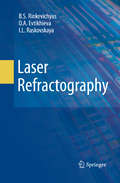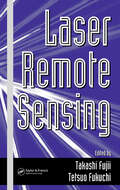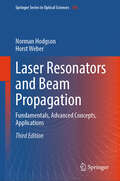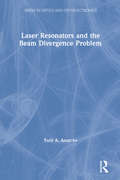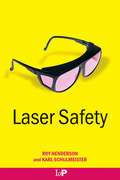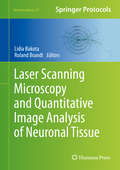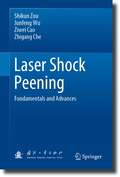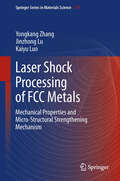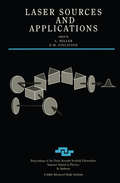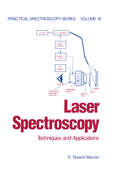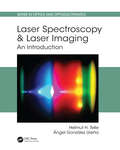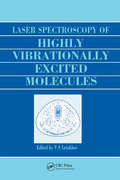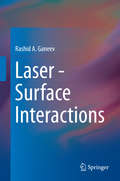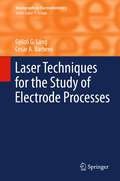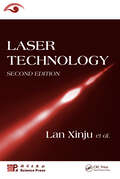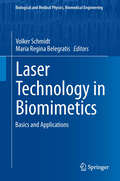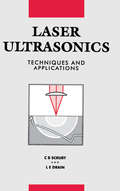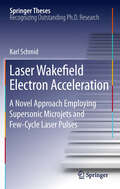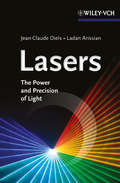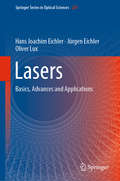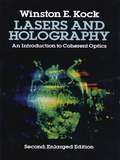- Table View
- List View
Laser Refractography
by I. L. Raskovskaya B. S. Rinkevichyus O. A. EvtikhievaThis book describes the basic principles of laser refractography, a flexible new diagnostic tool for measuring optically inhomogeneous media and flows. Laser refractography is based on digital imaging and computer processing of structured laser beam refraction (SLR) in inhomogeneous transparent media. Laser refractograms provide both qualitative and quantitative measurements and can be used for the study of fast and transient processes. In this book, the theoretical basis of refractography is explored in some detail, and experimental setups are described for measurement of transparent media using either 2D (passed radiation) or 3D (scattered radiation) refractograms. Specific examples and applications are discussed, including visualization of the boundary layer near a hot or cold metallic ball in water, and observation of edge effects and micro layers in liquids and gases. As the first book to describe this new and exciting technique, this monograph has broad cross-disciplinary appeal and will be of interest to students and researchers who need to characterize complex fluid behavior.
Laser Remote Sensing
by Takashi Fujii Tetsuo FukuchiInformation on recent progress in laser remote sensor (LIDAR) technology can be found scattered throughout numerous journal articles and conference proceedings, but until now there has been no work that summarizes recent advancements and achievements in the field in a detailed format.Laser Remote Sensing provides an up-to-date, comprehensiv
Laser Resonators and Beam Propagation: Fundamentals, Advanced Concepts, Applications (Springer Series in Optical Sciences #108)
by Norman Hodgson Horst WeberThis book delivers a uniquely comprehensive and detailed discussion of the properties of optical resonators and the propagation of laser beams, covering basic theory and practical implementations including recent research. It presents the fundamental theories of resonators, such as geometrical optics, diffraction, and polarization, as well as the characteristics of important resonator schemes and their modelling. The book uses classical optics as a framework for discussing the characteristic parameters of light, such as coherence, polarization, beam size and divergence, and understanding the most fundamental laws of light propagation, including the generation and tailoring of laser beams using optical resonators in continuous-wave, Q-switched and modelocked laser operation. Intra-cavity and extra-cavity harmonic generation are discussed as well. The long-anticipated third edition features considerable expansions and updates, with a new section on ultrafast pulse generation and propagation and mode-locked laser resonators. These, combined with the carefully structured text and autonomous nature of the chapters, make the book ideal for newcomers and invaluable to specialists in both academic and industry research.
Laser Resonators and the Beam Divergence Problem
by Yurii A. Anan'evProfessor Yurii A. Anan'ev has a long-standing international reputation for his publications on optical beams and resonators. Now many of his contributions will be readily available for the first time in a book. The generation of maximum power, minimum divergence beams from laser resonators is probably the most important topic in quantum electronics and optics today. The only book of its kind, Laser Resonators and the Beam Divergence Problem covers not only the theory, but also the applications of resonators to real systems as opposed to idealized models. Each rigorous examination of an optical configuration is accompanied by a detailed discussion of its associated applications and of the considerations for the user in practical work. The book contains a wealth of information on the developments in resonator technology, including much material previously unavailable outside the Soviet Union. It is an essential reference source to every researcher in laser science and technology.
Laser Safety
by Roy Henderson Karl SchulmeisterCovering both underlying theory and practical applications, Laser Safety provides a unique and readily-understandable review of current laser safety. This resource explains in detail the biological effects of laser radiation, particularly on the eye, and the provisions and requirements of the international laser safety standard IEC 60825-1, includi
Laser Safety: Tools and Training, Second Edition (Optical Science and Engineering)
by Barat KenNew chapters and updates highlight the second edition of Laser Safety: Tools and Training. This text provides background information relating to lasers and laser safety, and examines the components of laser work and laser safety from a different perspective. Written by a working laser safety officer, the book considers ways to keep users, as well as those around them, safe. The author encourages readers to think beyond protective eyewear. As it relates to safety, he determines that if eyewear is required, then the laser system is not ideal. This book factors in optics, the vibration elements of the optical table, the power meter, and user training, elements that are not commonly considered in the context of laser safety. It presents ways for users to evaluate the hazards of any laser procedure and ensure that they are following documented laser safety standards. The material serves as a fundamental means or road map for laser users seeking to utilize the safest system possible. What’s New in the Second Edition: The second edition provides an inclusion of the Z136.8 Research Laser Standard, and offers updates and an explanation of eye exposure limits (MPE), presents new cases studies, and presents practical example images. It includes coverage of, laser lab design lessons, addresses user facility challenges and laser disposal. Presents case studies of real accidents, preventive measures, and templates for documenting potential laser risks and attendant safety measures Reviews factors often overlooked when one is setting up a laser lab Demonstrates how to investigate a laser incident This text which includes fundamental laser and laser safety information, as well as critical laser use information, is appropriate for both the novice and the seasoned professional.
Laser Scanning Microscopy and Quantitative Image Analysis of Neuronal Tissue
by Lidia Bakota Roland BrandtLaser Scanning Microscopy and Quantitative Image Analysis of Neuronal Tissue brings together contributions from research institutions around the world covering pioneering applications in laser scanning microscopy and quantitative image analysis and providing information about the power and limitations of this quickly developing field. This detailed volume seeks to introduce key questions, to provide detailed information on how to acquire data by laser-scanning microscopy, and to examine how to use the often huge digital data set in an efficient manner to extract maximum information. Thus the book not only provides a compilation of diverse protocols but aims to bring together biological bench work, laser scanning microscopy, and mathematical, computer-assisted data analysis to grasp novel insights of form, dynamics, and interactions of microscopy-sized biological objects. Written in the popular Neuromethods series format, chapters include the kind of practical implementation advice that promises successful results. Wide-ranging and innovative, Laser Scanning Microscopy and Quantitative Image Analysis of Neuronal Tissue will stimulate the reader to make efficient use of the application of laser scanning microscopy for his or her own research question.
Laser Shock Peening: Fundamentals and Advances
by Shikun Zou Junfeng Wu Ziwei Cao Zhigang CheThis book highlights the fundamentals and latest progresses in the research and applications of laser shock peening (LSP). As a novel technology for surface treatment, LSP greatly improves the resistance of metallic materials to fatigue and corrosion. The book presents the mechanisms, techniques, and applications of LSP in a systematic way. It discusses a series of new progresses in fatigue performance improvement of metal parts with LSP. It also introduces lasers, equipment, and techniques of newly developed industry LSP, with a detailed description of the novel LSP blisk. The book demonstrates in details numerical analysis and simulation techniques and illustrates process stability control, quality control, and analysis determination techniques. It is a valuable reference for scientists, engineers, and students in the fields of laser science, materials science, astronautics, and aeronautics who seek to understand, develop, and optimize LSP processes.
Laser Shock Processing of FCC Metals
by Jinzhong Lu Kaiyu Luo Yongkang ZhangLaser shock processing (LSP) is a new and promising surface treatment technique for improving the fatigue durability, corrosion, wear resistance and other mechanical properties of metals and alloys. During LSP, the generated shock wave can introduce a deep compressive residual stress into the material, due to its high-pressure (GPa-TPa), ultra-fast (several tens nanoseconds), ultra-high strain-rate and high-energy. The overall properties and behavior of metal materials subjected to LSP were significantly improved because a refined surface layer was successfully obtained. Nevertheless, up to now, a clear scenery between micro-structure and macro-property of the refined surface layer, especially formation of sub-micrometer grains from coarse grains during severe plastic deformation, is still pending. Therefore, the basic studies of the underlying mechanism for grain refinement by ultra-high strain-rate presented in this book becomes more and more crucial.
Laser Shocking Nano-Crystallization and High-Temperature Modification Technology
by Xudong RenThe aim of this book is to present foundational research on the nano-crystallization, high-temperature modification, micro-structure evolution and plastic deformation induced by laser shock processing. In this regard, the focus is on heat-resistant steel, aluminum alloy, Ti alloys and Ni-based alloys, offering valuable scientific insights into the industrial applications of laser shock processing (LSP) technology. The book addresses various topics, i. e. , the formation mechanism and productivity improvement of nano-crystalline diamond by laser processing, the surface integrity and fatigue lives of heat-resistant steels, Ti alloys and Ni-based alloys after LSP with different processing parameters, tensile properties and fractural morphology after LSP at different temperatures, strain-rates and grain refinement mechanisms based on the micro-structure evolution. Moreover, the effect of heating temperature and exposure time on stress thermal relaxation and the influence of compressive stress on the stress intensity factor of hole-edge cracks by high strain rate laser shock processing are also analyzed. A new type of statistical data model to describe the fatigue cracking growth with limited data is proposed based on the consideration of the effects of fracture growth on the reliability and confidence level. This book is intended for researchers, engineers and postgraduates in the fields of nanotechnology and micro-engineering who are interested in the partial or overall strengthening of materials, especially those with a focus on surface integrity and fatigue life.
Laser Sources and Applications (Scottish Graduate Ser.)
by A Miller; D M Finlayson; P OsborneRecent years have witnessed rapid advances in the development of solid state, fiber, semiconductor, and parametric sources of coherent radiation, which are opening up new opportunities for laser applications. Laser Sources and Applications provides a tutorial introduction to the basic principles of these developments at a level suitable for postgraduate research students and others with a basic knowledge of lasers and nonlinear optics. Encompassing both the physics and engineering aspects of the field, the book covers the nature of nonlinear optical interactions; solid state, fiber, and semiconductor lasers; optical parametric oscillators; and ultrashort pulse generation and applications. It also explores applications of current interest, such as electromagnetically induced transparency, atomic trapping, and soliton optical communications.
Laser Spectroscopy: Techniques and Applications (Practical Spectroscopy)
by E. Roland MenzelThis work describes experimental techniques using laser spectroscopy and presents specific practical applications for this technology in many fields, including physics, engineering, chemistry, medicine and bioscience. The general spectroscopic features of molecules are delineated; transition metal and rare earth complexes are examined; and transition selection rules are explained.
Laser Spectroscopy and Laser Imaging: An Introduction (Series in Optics and Optoelectronics)
by Helmut H. Telle Ángel González UreñaHow would it be possible to provide a coherent picture of this field given all the techniques available today? The authors have taken on this daunting task in this impressive, groundbreaking text. Readers will benefit from the broad overview of basic concepts, focusing on practical scientific and real-life applications of laser spectroscopic analysis and imaging. Chapters follow a consistent structure, beginning with a succinct summary of key principles and concepts, followed by an overview of applications, advantages and pitfalls, and finally a brief discussion of seminal advances and current developments. The examples used in this text span physics and chemistry to environmental science, biology, and medicine.
Laser Spectroscopy of Highly Vibrationally Excited Molecules
by Vladilen Stepanovich LetokhovLaser spectroscopy has been perfected over the last fifteen years to become a precise tool for the investigation of highly vibrationally excited molecules. Intense infrared laser radiation permits both the multiple-photon resonant excitation and the dissociation of polyatomic molecules. In this book, the latest results of some of the foremost Soviet researchers are published for the first time in the West. Laser Spectroscopy of Highly Vibrationally Excited Molecules contains a comprehensive study of both the experimental and theoretical aspects of the basic photophysical interactions that occur in these processes. The book first focuses on the nonlinear interaction between the resonant vibrational mode and the intense infrared field and then examines the nonlinear interaction between the vibrational modes themselves due to anharmonicity. These interrelated processes determine all the characteristics of polyatomic molecules in an infrared field. The book also discusses related phenomena such as spectra broadening, optical resonance, photon echoes, and dynamical chaos. It includes examples of multiple-photon resonant excitation such as the excitation of OsO4 by CO^O2 laser radiation, which is detected by the visible luminescence that results. This book will be of great interest to researchers and postgraduate students in infrared laser spectroscopy and the laser chemistry of molecules and applications of isotope separation.
Laser - Surface Interactions
by Rashid A. GaneevThis book is about the interaction of laser radiation with various surfaces at variable parameters of radiation. As a basic principle of classification we chose the energetic or intensity level of interaction of laser radiation with the surfaces. These two characteristics of laser radiation are the most important parameters defining entire spectrum of the processes occurring on the surfaces during interaction with electromagnetic waves. This is a first book containing a whole spectrum of the laser-surface interactions distinguished by the ranges of used laser intensity. It combines the surface response starting from extremely weak laser intensities (~1 W cm-2) up to the relativistic intensities (~1020 W cm-2 and higher). The book provides the basic information about lasers and acquaints the reader with both common applications of laser-surface interactions (laser-related printers, scanners, barcode readers, discs, material processing, military, holography, medicine, etc) and unusual uses of the processes on the surfaces under the action of lasers (art conservation, rangefinders and velocimeters, space and earth explorations, surface engineering and ablation, and others). The scientific applications of laser-surfaces interactions (surface optical nonlinearities, surface enhanced Raman spectroscopy, surface nanostructuring, nanoripples and clusters formation, X-ray lasers and harmonic generation from the surfaces) are discussed from the point of view of the close relations between the properties of surface and matter, which is a cornerstone of most of studies of materials. The novelty of the approach developed in Laser - Surface Interactions is related with the interconnection of scientific studies with numerous applications of the laser-surface interactions separated in different chapters by the ranges of laser intensities. We present most recent achievements in this field. The book provides valuable information for different ranges of reader's preparedness to the laser-related topics (from unprepared readers, to students, engineers and researchers, professionals and academics).
Laser Techniques for the Study of Electrode Processes
by Cesar A. Barbero Gyözö G. LángLaser-enabled measurements are valuable tools for the investigation of surfaces and interfaces or for the in situ investigation of interfacial processes including electrode processes. The understanding of the thermodynamics of solid/liquid surfaces is important for surface science and electrochemistry. In the first part of this book, the authors describe a range of techniques for investigating interfacial tension and surface stress, which is important for coatings, thin films, and fuel cells. The techniques covered comprise bending beam (bending plate, bending cantilever, wafer curvature) methods with different detection techniques. Special attention is given to methods using optical detection by laser beam deflection or interferometry. The second part is devoted to the techniques based on the detection of refractive index gradients in the solution. The refractive index changes could be related to concentration gradients (Probe Beam Deflection, PBD) or light-induced thermal gradients (Photothermal Deflection Spectroscopy, PDS). The application of the techniques to surface-confined and solution electrochemical systems is described. Subsequently, a comparison with others techniques able to monitor ion fluxes is performed.
Laser Technology
by Lan XinjuAs different laser technologies continue to make it possible to change laser parameters and improve beam quality and performance, a multidisciplinary theoretical knowledge and grasp of cutting-edge technological developments also become increasingly important. The revised and updated Laser Technology, Second Edition reviews the principles and basic
Laser Technology in Biomimetics
by Volker Schmidt Maria Regina BelegratisLasers are progressively more used as versatile tools for fabrication purposes. The wide range of available powers, wavelengths, operation modes, repetition rates etc. facilitate the processing of a large spectrum of materials at exceptional precision and quality. Hence, manifold methods were established in the past and novel methods are continuously under development. Biomimetics, the translation from nature-inspired principles to technical applications, is strongly multidisciplinary. This field offers intrinsically a wide scope of applications for laser based methods regarding structuring and modification of materials. This book is dedicated to laser fabrication methods in biomimetics. It introduces both, a laser technology as well as an application focused approach. The book covers the most important laser lithographic methods and various biomimetics application scenarios ranging from coatings and biotechnology to construction, medical applications and photonics.
Laser Ultrasonics Techniques and Applications
by L.E DrainThe first book devoted to laser techniques in the generation and reception of ultrasonic waves in materials, Laser Ultrasonics: Techniques and Applications provides a full description of the state of the art in all fields involving both lasers and ultrasonics. This practical book focuses mainly on the possible applications of the techniques, yet th
Laser Velocimetry in Fluid Mechanics
by Alain BoutierIn fluid mechanics, velocity measurement is fundamental in order to improve the behavior knowledge of the flow. Velocity maps help us to understand the mean flow structure and its fluctuations, in order to further validate codes.Laser velocimetry is an optical technique for velocity measurements; it is based on light scattering by tiny particles assumed to follow the flow, which allows the local fluid flow velocity and its fluctuations to be determined. It is a widely used non-intrusive technique to measure velocities in fluid flows, either locally or in a map.This book presents the various techniques of laser velocimetry, as well as their specific qualities: local measurements or in plane maps, mean or instantaneous values, 3D measurements. Flow seeding with particles is described with currently used products, as well as the appropriate aerosol generators. Post-processing of data allows us to extract synthetic information from measurements and to perform comparisons with results issued from CFD codes. The principles and characteristics of the different available techniques, all based on the scattering of light by tiny particles embedded in the flow, are described in detail; showing how they deliver different information, either locally or in a map, mean values and turbulence characteristics.
Laser Wakefield Electron Acceleration
by Karl SchmidThis thesis covers the few-cycle laser-driven acceleration of electrons in a laser-generated plasma. This process, known as laser wakefield acceleration (LWFA), relies on strongly driven plasma waves for the generation of accelerating gradients in the vicinity of several 100 GV/m, a value four orders of magnitude larger than that attainable by conventional accelerators. This thesis demonstrates that laser pulses with an ultrashort duration of 8 fs and a peak power of 6 TW allow the production of electron energies up to 50 MeV via LWFA. The special properties of laser accelerated electron pulses, namely the ultrashort pulse duration, the high brilliance, and the high charge density, open up new possibilities in many applications of these electron beams.
Lasers: The Power and Precision of Light (Optics And Photonics Ser.)
by Jean-Claude Diels Ladan Arissian"Lasers" are active ingredients of our modern life, but they are inconspicuous as they often go unnoticed. This intuitive introductory guide will tell you all you want to know about laser technologies in very diverse fields from nuclear and particle physics to medicine, astronomy and ultra-precise metrology. The book is coherently focused on fundamentals, and is aimed to stimulate intuition about present and future applications, while unveiling the halo of myths around lasers. Written by reputable laser experts who think that science should be entertaining, this useful reference relies on simple analogies and illustrations rather than complex mathematics, and will be suitable for students and end-users of laser technologies, including novices.Voted a CHOICE Outstanding Academic Title 2012
Lasers: Basics, Advances and Applications (Springer Series in Optical Sciences #220)
by Hans Joachim Eichler Jürgen Eichler Oliver LuxThis book provides a comprehensive overview of laser sources and their applications in various fields of science, industry, and technology. After an introduction to the basics of laser physics, different laser types and materials for lasers are summarized in the context of a historical survey, outlining the evolution of the laser over the past five decades. This includes, amongst other aspects, gas lasers, excimer lasers, the wide range of solid-state and semiconductor lasers, and femtosecond and other pulsed lasers where particular attention is paid to high-power sources. Subsequent chapters address related topics such as laser modulation and nonlinear frequency conversion. In closing, the enormous importance of the laser is demonstrated by highlighting its current applications in everyday life and its potential for future developments. Typical applications in advanced material processing, medicine and biophotonics as well as plasma and X-ray generation for nanoscale lithography are discussed. The book provides broad and topical coverage of laser photonics and opto-electronics, focusing on significant findings and recent advances rather than in-depth theoretical studies. Thus, it is intended not only for university students and engineers, but also for scientists and professionals applying lasers in biomedicine, material processing and everyday consumer products. Further, it represents essential reading for engineers using or developing high-power lasers for scientific or industrial applications.
Lasers
by Jeanette LeardiLasers are a special type of light. They can cut through steal, look inside the brain of a fly, and help is explore hidden places. They are used in medical operations, at rock concerts, and in everyday items such as DVDs. How do lasers work? How have they become such a huge part of our lives in less than fifty years? Read this book to find out. (Includes 6 copies of the title, Teacher's Guide and Comprehension Question Card)
Lasers and Holography
by Winston E. KockAs the words holo (complete) and gram (message) connote, the hologram captures the entire message of a scene in all its visual properties, including the realism of three dimensions. It involves the simple process of photographically recording the pattern formed by two interfering sets of light waves, one of these sets being a reference wave. With the introduction of lasers to holography in 1963, real advances in the development of holography began to take place.Dr. Kock's lucid introduction to lasers and holography has now been revised and updated for a second edition. It begins with a clear discussion of wave patterns and coherence. Then the development of lasers is summarized, along with the phenomenon of wave diffraction. Finally, the important subjects of zone plates and the properties of holograms are skillfully described. A new, concluding chapter brings the story up to the present, with a survey of recent advances in such areas as viewing holograms, hologram computer memories, liquid surface holography, synthetic-aperture radar and sonar, large new lasers, fiber optics, etc. Using language that can be readily understood by high school and junior high school students, Dr. Kock has written a brief, yet authoritative volume that should satisfy anyone's curiosity about this burgeoning field. The remarkable discoveries that have already occurred are only a prelude to an even more remarkable future. 84 illustrations, including 8 new to this edition. New preface. Suggested (1981) additional reading. Index.
